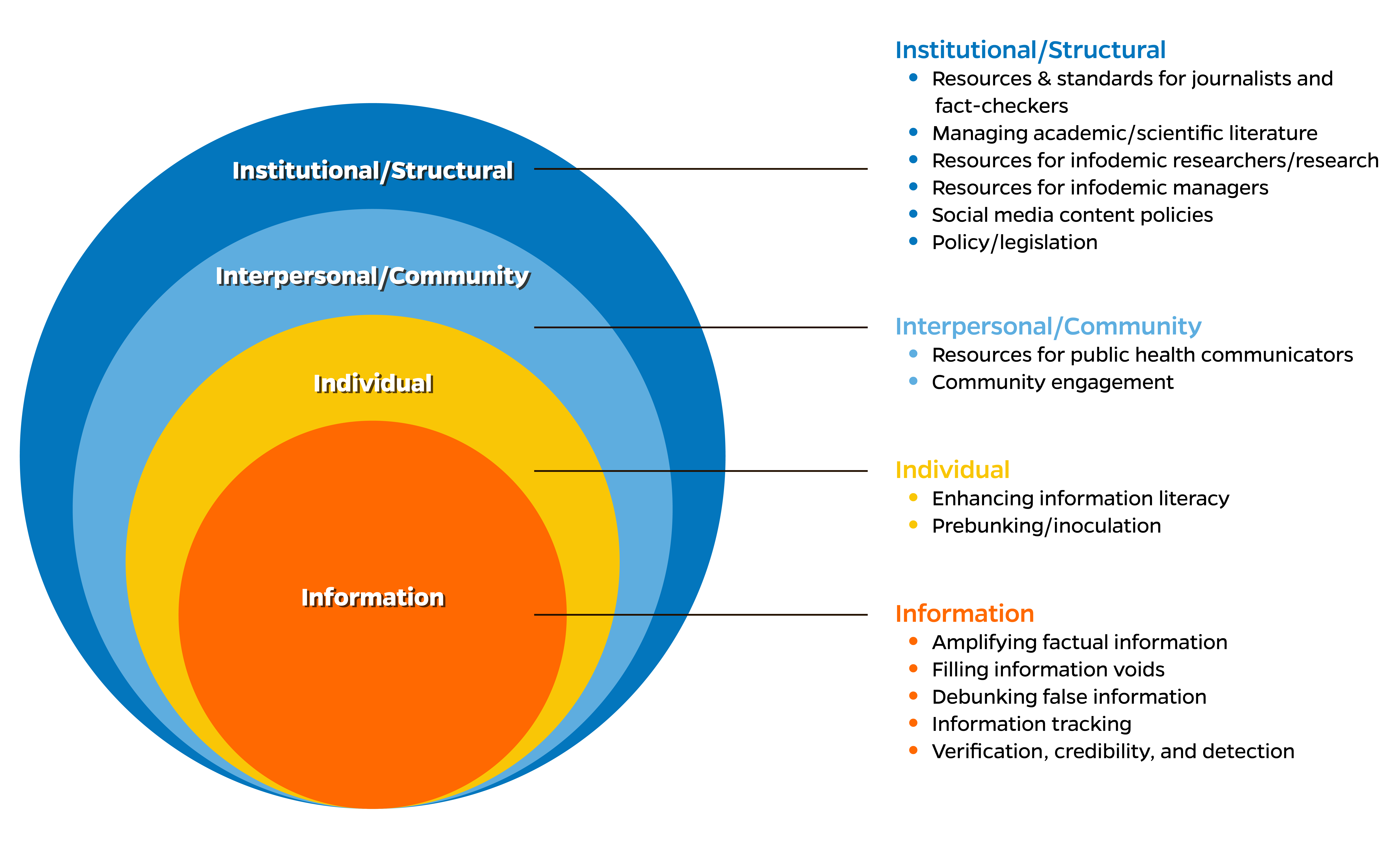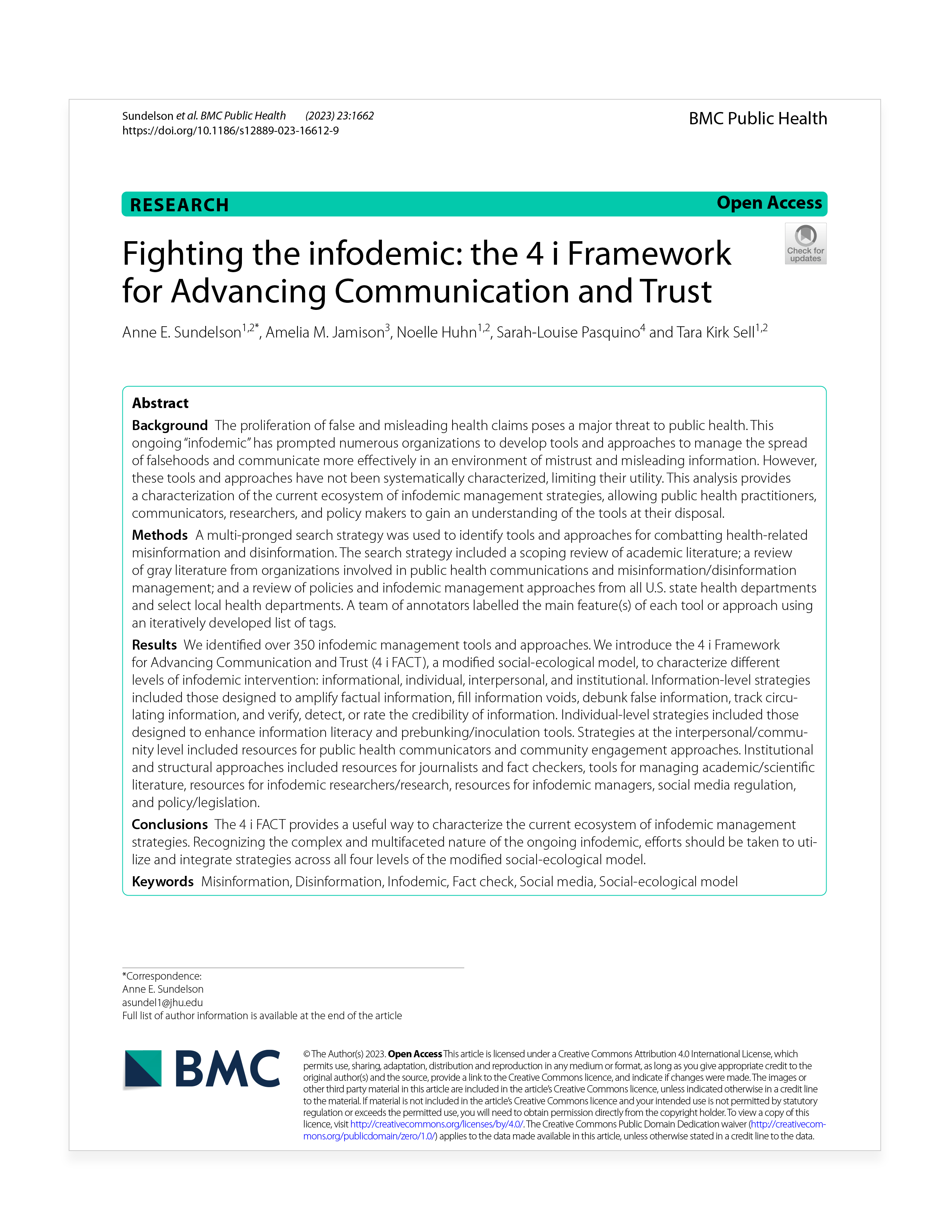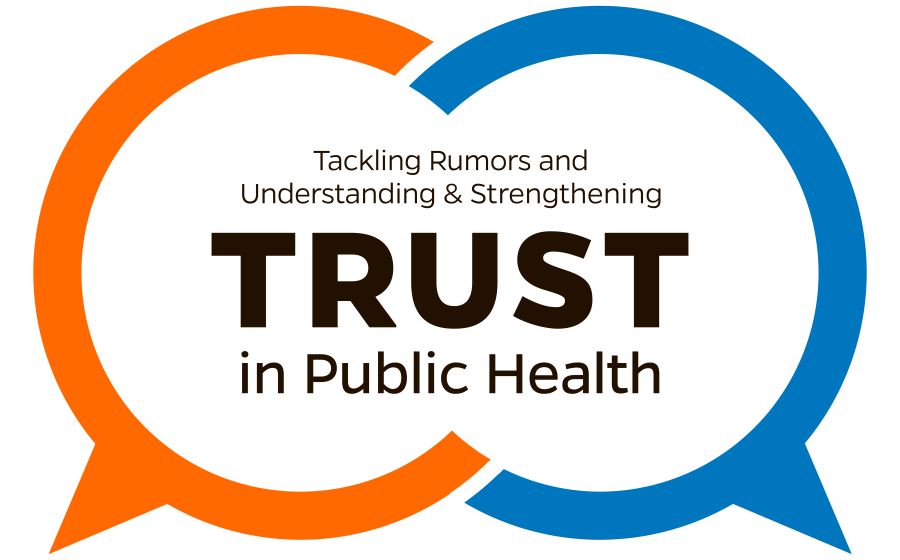
Approaches to manage and counter misleading rumors and deliberately false narratives
In recent years, numerous tools and approaches have been developed to counter misleading health-related information and enhance public health communication in an environment of mistrust. To provide practitioners with an overview of these tools and approaches, the project team developed the 4 i Framework for Advancing Communication and Trust (4 i FACT). This framework is based on a review of more than 350 information management and communication resources, tools, and approaches that were published or available in the public domain as of March 2023.

The 4 i FACT is a modified social-ecological model that outlines 4 possible levels of intervention: information, individual, interpersonal/community, and institutional/structural. Within each level is a menu of possible strategies for preventing, managing, and/or mitigating the negative impacts of health-related rumors and enhancing communication in an environment of mistrust.
Levels of intervention
Information-Level Approaches
This level consists of strategies that target information in all forms, including false or misleading information, accurate information, and insufficient information (also known as information voids).
Amplifying factual information: Approaches that increase the volume, reach, and accessibility of accurate information.
- Example: Dear Pandemic was a social media campaign that amplified easily understandable, factual information about COVID-19 and other public health issues to Instagram users.
Filling information voids: Efforts to address information deficits by filling gaps in knowledge or understanding with accurate information.
- Example: The Conversation: Between Us, About Us is a series of videos in which a diverse group of healthcare workers answered common questions about COVID-19 and vaccines to dispel rumors.
Debunking: Involves refuting or correcting circulating false information.
- Example: #CoronavirusFactsAlliance was an online collection of fact-checked and corrected rumors about COVID-19.
Information tracking: Efforts to monitor trends in circulating information, including the presence (or absence) of rumors.
- Example: The WHO Early AI-Supported Response with Social Listening (EARS) Platform was a digital platform that used artificial intelligence to track online conversations about infectious diseases.
Credibility/verification/detection: Tools that alert individuals to potentially false information, verify accurate information, or provide insight into the credibility of information sources.
- Example: rbutr is a browser extension that informs users whether the content they are viewing has been refuted elsewhere online.
Individual-Level Approaches
This level includes strategies to enhance individual-level resiliency to misleading or purposefully manipulated narratives.
Enhancing information literacy: Efforts to encourage or teach individuals to become more careful, thoughtful, and skilled consumers of information, including health/science-related information and digital information.
- Example: San Diego County Health Department’s “Evaluating COVID-19 Information” is a webpage that informs users about how to find and critically evaluate scientific information about COVID-19.
Prebunking/inoculation: Refuting anticipated false narratives before they spreads (prebunking) or teaching about tricks commonly used to mislead (inoculation). These tactics act like a vaccine, by providing individuals with protection from future attempts to mislead them.
- Example: Go Viral! is an online game in which users learn how to create viral false content about COVID-19. In doing so, they build mental resistance to techniques commonly used to manipulate people.
Interpersonal/Community-Level Approaches
This level consists of strategies and resources to enhance public health communication and build, maintain, and use relationships at the interpersonal and community levels.
Resources for public health communicators: Manuals, frameworks, general guidance, and/or pre-scripted materials or messages to enhance the efficacy of public health communication.
- Example: Public Health Communications Collaborative’s (PHCC) Messaging Resources is a collection of public health messaging resources, including toolkits, graphics, and talking points about various health issues.
Community engagement: Efforts to build and maintain trust with communities and identify and use trusted community messengers.
- Example: International Vaccine Access Center’s vaccination promotion campaign trained faith leaders (trusted community messengers) in Baltimore to provide information about COVID-19 vaccines to community members. These partnerships also allowed vaccine clinics to be held in churches, where people felt more comfortable asking questions or discussing concerns.
Institutional/Structural-Level Approaches
This level includes strategies to address misleading rumors or purposefully manipulated narratives by changing or supporting structural and institutional processes and systems (eg, the political landscape, the media environment, etc.). It might be difficult for public health workers, particularly those at the local level, to alter the systems and processes that can spread inaccurate or false narratives that can cause mistrust. However, many of the resources outlined below may still be useful.
Resources and standards for journalists/fact-checkers: Efforts to ensure journalists and fact-checkers have adequate resources and knowledge to conduct their work responsibly and in a way that promotes facts.
- Example: International Center for Journalists’ (ICFJ) Global Health Crisis Reporting Forum is an online project that provides journalists covering health emergencies with coverage tips and up-to-date, factual information.
Managing academic/scientific literature: Tools and resources to help public health practitioners, communicators, and other professionals stay up to date with emerging scientific evidence.
- Example: Covid Contents Initiative was an Italian government-led initiative to set up a working group to review new scientific literature on COVID-19. The group summarized its findings in a weekly open-access report.
Resources for health communication researchers/research: Efforts to encourage or facilitate research into infodemics, which is the overabundance of information—both accurate and inaccurate—related to health events.
- Example: The Mercury Project is a funding mechanism for researchers conducting work related to infodemiology or information management.
High-level resources for leadership roles: Efforts to enhance public health or industry leaders’ ability to manage information by providing them with frameworks or guidance.
- Example: WHO Framework for Managing the COVID-19 Infodemic is a high-level framework for managing the COVID-19 infodemic based on results of a crowd-sourced WHO technical consultation.
Social media content policies: Efforts to reduce the spread or impact of misleading or false narratives on social media platforms.
- Example: Meta’s COVID-19 policies, which included removing or regulating the sharing of certain posts, helped reduce the spread of false narratives about COVID-19 on Facebook.
Policy/legislation: Legislative and regulatory actions to reduce the spread of misleading or false narratives or promote widespread literacy training.
- Example: Health Misinformation Act of 2021 was a proposed bill to reform Section 230 of the Communications Decency Act by making social media platforms liable for promoting the spread of false narratives using algorithms during public health emergencies.

To learn more about 4 i FACT, please read the following publication:
Fighting the infodemic: the 4 i Framework for Advancing Communication and Trust by AE Sundelson, AM Jamison, N Huhn, S Pasquino & TK Sell (2023)
Please note: The information in this section provides an overview of tools and approaches to manage misleading rumors and enhance communication in an environment of mistrust as of March 2023, when the project's information-gathering portion concluded. Determining which tools and approaches are best for specific situations requires a customized approach, as highlighted in the Practical Playbook for Addressing Health Rumors.

